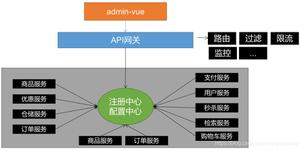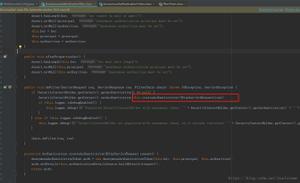spring aop 环绕通知around和其他通知的区别
本文内容纲要:spring aop 环绕通知around和其他通知的区别
前言:
spring 的环绕通知和前置通知,后置通知有着很大的区别,主要有两个重要的区别:
1) 目标方法的调用由环绕通知决定,即你可以决定是否调用目标方法,而前置和后置通知 是不能决定的,他们只是在方法的调用前后执行通知而已,即目标方法肯定是要执行的。
2) 环绕通知可以控制返回对象,即你可以返回一个与目标对象完全不同的返回值,虽然这很危险,但是你却可以办到。而后置方法是无法办到的,因为他是在目标方法返回值后调用
这里是经过我自己测试的过的例子,使用面向切面来处理一些问公共的问题,比如,权限管理,事务的委托
下面的例子就是使用环绕通知,当程序发生异常时,重复提交请求,重复的次数是可以设定的
当我们开发企业级应用时,通常会想要从几个切面来引用模块化的应用和特定操作的集合,下面是一个典型的通用切面,看起来可能像下面这样(这也是Spring文档里的)
package test.prefer.aspect;
import org.aspectj.lang.annotation.Aspect;
import org.aspectj.lang.annotation.Pointcut;
@Aspect
public class SystemArchitecture {
/**
* A join point is in the web layer if the method is defined
* in a type in the com.xyz.someapp.web package or any sub-package
* under that.
*/
@Pointcut("within(com.xyz.someapp.web..*)")
public void inWebLayer() {}
/**
* A join point is in the service layer if the method is defined
* in a type in the com.xyz.someapp.service package or any sub-package
* under that.
*/
@Pointcut("within(com.xyz.someapp.service..*)")
public void inServiceLayer(){}
/**
* A join point is in the data access layer if the method is defined
* in a type in the com.xyz.someapp.dao package or any sub-package
* under that.
*/
@Pointcut("within(com.xyz.someapp.dao..*)")
public void inDataAccessLayer(){}
/**
* A business service is the execution of any method defined on a service
* interface. This definition assumes that interfaces are placed in the
* "service" package, and that implementation types are in sub-packages.
*
* If you group service interfaces by functional area (for example,
* in packages com.xyz.someapp.abc.service and com.xyz.def.service) then
* the pointcut expression "execution(* com.xyz.someapp..service.*.*(..))"
* could be used instead.
*
* Alternatively, you can write the expression using the 'bean'
* PCD, like so "bean(*Service)". (This assumes that you have
* named your Spring service beans in a consistent fashion.)
*/
@Pointcut("execution(* test.prefer.aspect.*.*(..))")
public void businessService(){}
/**
* A data access operation is the execution of any method defined on a
* dao interface. This definition assumes that interfaces are placed in the
* "dao" package, and that implementation types are in sub-packages.
*/
@Pointcut("execution(* com.xyz.someapp.dao.*.*(..))")
public void dataAccessOperation(){}
}
一、定义自己的一个切面
/*
*文件名:ConcurrentOperationExecutor.Java
*描述:<描述>
*修改人:Administrator
*/
package test.prefer.aspect;
import org.aspectj.lang.ProceedingJoinPoint;
import org.aspectj.lang.annotation.Around;
import org.aspectj.lang.annotation.Aspect;
import org.springframework.core.Ordered;
/**
* @author
*@date 2010-6-1
*/
@Aspect
public class ConcurrentOperationExecutor implements Ordered {
private static final int DEFAULT_MAX_RETRIES = 2;
private int maxRetries = DEFAULT_MAX_RETRIES;
private int order = 1;
public void setMaxRetries(int maxRetries) {
this.maxRetries = maxRetries;
}
public int getOrder(){
return this.order;
}
public void setOrder(int order){
this.order = order;
}
@Around("test.prefer.aspect.SystemArchitecture.businessService()")
public Object doConcurrentOperation(ProceedingJoinPoint pjp) throws Throwable {
//环绕通知处理方法
int numAttempts = 0;
Exception lockFailureException;
do {
numAttempts++;
try {
System.out.println("环绕通知方法[ doConcurrentOperation(ProceedingJoinPoint pjp) ].............");
return pjp.proceed();
}
catch(Exception ex) {
lockFailureException = ex;
}
}
while(numAttempts <= this.maxRetries);
throw lockFailureException;
}
}
说明:
请注意切面实现了 Ordered 接口,这样我们就可以把切面的优先级设定为高于事务通知 (我们每次重试的时候都想要在一个全新的事务中进行)。maxRetries和order 属性都可以在Spring中配置。主要的动作在doConcurrentOperation这个环绕通知方法中发生。 请注意这个时候我们所有的businessService()方法都会使用这个重试策略。 我们首先会尝试处理,如果得到一个Exception异常, 我们仅仅重试直到耗尽所有预设的重试次数(spring开发文档)
二、在配置文件里配置这个切面
aop:aspectj-autoproxy/
好了,下面我们就试一下效果吧
三、测试效果
1)新建一个测试的bean: MyTestAspect,代码如下:
package test.prefer.aspect;
/**
* 这是一个切面类
*/
import org.aspectj.lang.annotation.Aspect;
public class MyTestAspect {
int k=0;
public void test(String args) throws Exception{
System.out.println("这里是[ 目标 ]方法test()"+ ++k);
if(k<2){
throw new Exception();
}
}
}
这个类必须在连接点的包或者子包下面,
在SystemArchitecture里有定义
@Pointcut("execution(* test.prefer.aspect.*.*(..))")
public void businessService(){}
2)applicationContext.xml里配置 MyTestAspect
3)好了,看看效果吧
package test;
import org.springframework.context.ApplicationContext;
import org.springframework.context.support.ClassPathXmlApplicationContext;
import test.prefer.aspect.MyTestAspect;
public class example {
public static void main(String args[]){
ApplicationContext ctx = new ClassPathXmlApplicationContext("applicationContext.xml");
MyTestAspect t =(MyTestAspect)ctx.getBean("test");
try{
t.test("");
}catch(Exception e){
System.out.println("main()中处理异常"+e);
}
}
}
输出结果是:
环绕通知方法[ doConcurrentOperation(ProceedingJoinPoint pjp) ].............
这里是[ 目标 ]方法test()1
环绕通知方法[ doConcurrentOperation(ProceedingJoinPoint pjp) ].............
这里是[ 目标 ]方法test()
本文内容总结:spring aop 环绕通知around和其他通知的区别
原文链接:https://www.cnblogs.com/gmq-sh/p/6018587.html
以上是 spring aop 环绕通知around和其他通知的区别 的全部内容, 来源链接: utcz.com/z/362834.html









